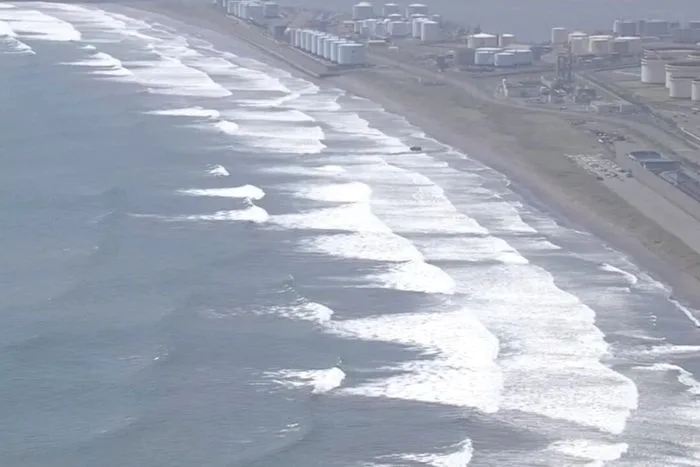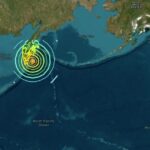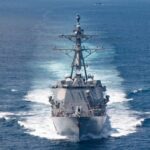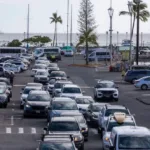By Melanie Sun
An 8.8 magnitude earthquake has hit off the east coast of Russia, triggering tsunami warnings across the northern Pacific Ocean and a tsunami watch for the entire U.S. West Coast. At 9:26 p.m. PT, the National Weather Service upgraded the watch to a tsunami warning from Cape Mendocino, about 200 miles north of San Francisco, to north of the California-Oregon border.
The quake, which struck at 7:24 p.m. ET, had an epicenter off Russia’s Kamchatka Peninsula that was big enough to cause a tsunami, the U.S. Geological Survey (USGS) said.
It revised the magnitude up from 8.0 earlier.
An 8.8 magnitude earthquake ranks among the top six largest ever recorded.
According to the National Weather Service’s (NWS’s) tsunami warning center, tsunami waves from the quake were confirmed by ocean buoys near the epicenter.
Tsunami warnings were issued for Alaska, Hawaii, and other Pacific Islands, while a tsunami watch was issued for the U.S. WestCoast as well as Guam, the Northern Mariana Islands, American Samoa, and other islands of Micronesia.
The Pacific Tsunami Warning Center said impacts were possible for some coastal areas of Central and South America, including waves of 1 to 3 metres (3 to 10 feet) above tide level in Ecuador and Chile.
U.S. President Donald Trump drew attention to the tsunami warnings for Alaska, Hawaii, and Pacific coasts with a post on Truth Social. “Stay strong and stay safe,” he wrote.
10-Foot Tsunami in Russia
Russian officials said that a tsunami with 10-foot waves has hit parts of Russia’s far eastern Kamchatka Peninsula near the earthquake’s epicenter. Buildings have been damaged and evacuations ordered, Sergei Lebedev, regional minister for emergency situations, said.
“Today’s earthquake was serious and the strongest in decades of tremors,” Kamchatka Gov. Vladimir Solodov said in a video posted on the Telegram messaging app. He added that according to preliminary information there were no injuries but a kindergarten was damaged.
Solodov urged people to move away from the coast, saying the earthquake was the “strongest in decades” in the area.
Waves Across Pacific
The first waves are forecast to arrive in Hawaii around 7:17 p.m. local time. “A tsunami has been generated that could cause damage along coastlines of all islands in the state of Hawaii,” the NWS said in the warning. “Urgent action should be taken to protect lives and property.”
Story continues below advertisement
“Tsunami wave heights cannot be predicted and the first wave may not be the largest. Tsunami waves efficiently wrap around islands. All shores are at risk no matter which direction they face,” the NWS bulletin said.
Hawaii’s Gov. Josh Green said that readings from Midway Atoll, around 1,300 miles northwest of Hawaii in the North Pacific Ocean, showed a tsunami wave of around 3 feet arriving around 6 p.m. According to historical records, this is the highest tsunami observation in open water ever recorded in the Northern Pacific.
Authorities urge people to stay out of the water, warning of strong and unusual currents.
Four-foot waves arrived at Kahului Beach on Maui island at 6:45 p.m. local time. Four-foot waves were also recorded at 6:48 p.m. local time at Haleiwa on Oahu’s northwest shores.
On the U.S. West Coast, the wave is expected to hit around midnight local time, according to the NWS. While wave heights for specific locations are hard to predict, the service put them at 0.8 to 5.6 feet.
Residents from Cape Mendocino to north of the Oregon border were told to evacuate.
On Canada’s west coast, the province of British Columbia issued a tsunami advisory for impact between 10:05-11:30 p.m. local time. “People in coastal areas that are at risk are advised to stay away from the shoreline and heed instructions from local authorities,” it said.
Following Russia, Japan was next to be impacted by the tsunami between 10 a.m. to 11:30 a.m. local time—almost 1.5 hours after the quake was felt in Russia. Waves of 2 feet arrived at Hamanaka in Japan’s northern island of Hokkaido, according to the Japan Meteorological Agency (JMA). Waves of up to 3 feet were forecast for parts of Hokkaido.
A tsunami of 8 inches was reported in Tokyo Bay. Shiji Kiyomoto from the JMA said that high waves may last for at least a day from the arrival of the first tsunami wave, urging residents to stay in safe places. He did not say when the tsunami alerts would be lifted.
Several aftershocks ranging from 5.5 to 6.9 in magnitude have been detected off the Kamchatka Peninsula since the first big quake.
Russia’s Far East sits on the Pacific Ring of Fire, a geologically active region that is prone to major earthquakes and volcanic eruptions.
Around 12 hours prior, a notable 7.0 magnitude quake struck the southern side of the Pacific Ring of Fire in the Macquarie Island region near Antarctica. Due to its remoteness, the USGS issued a “green alert” indicating a low likelihood of casualties and economic damage. No tsunami warning was issued after that quake.
Reuters contributed to this article.






